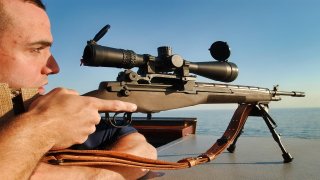The M14 Rifle Was Just an Oversized M1 Carbine
Though M14 variants have remained in use – notably as a sniper rifle and a designated marksman rifle, due largely to its accuracy and effectiveness at long range – it still served as the standard infantry rifle for just seven years.
Meet the M14 Rifle: At the end of the Second World War, General George S. Patton famously wrote that the M1 Garand was "the greatest battle implement ever devised." While few would ever suggest that Old Blood & Guts was kissing up, we should remember that Patton made the claim about the M1 in a letter to Major General Levin H. Campbell, Jr, the United States War Department's Chief of Ordnance.
It should also be added that when Patton's quote is used by those writing about the M1 Garand, often left out is the rest of the passage, which reads, "However, my admiration for Ordnance products does not stop with the M1-1 Rifle. Our machine guns, mortars, artillery, and tanks are without equal on the battlefields of the world."
Patton didn't live long enough to see the infantry weapons that were to come, and we can only guess what he might have thought about the M14, which was the last U.S. military rifle to be produced at the Springfield Armory in Springfield, Massachusetts. It was essentially an improved version of the M1 Garand that took features from the M1 Carbine.
In fact, it is hard not to see it as an oversized version of the M1 Carbine.
Even Greater Battle Implement – Not Quite
Even by the end of the Second World War, the U.S. military understood that the infantry needed more ammunition and greater adaptability. The U.S. wasn't alone in understanding this either. Nazi Germany pioneered the assault rifle with the StG-44; while after the war, the Soviet Union quickly went on to develop the AK-47.
Meanwhile, the designers at the Springfield Armory spent a dozen years and millions of dollars and ended up with a barely improved Garand. Worse still, the U.S. Army set out to replace everything in the inventory with a single platform.
The M14 was meant to supplant the M1 Garand, the M1 Thompson submachine gun, and the Browning Automatic Rifle (BAR). But the M14 was heavy and nearly impossible to control on full auto. It was arguably designed for past conflicts, not the war that the U.S. would find itself in next – namely, the war in Vietnam, where it would have its baptism of fire.
The M14 served the shortest stint of any battle rifle in the U.S. military – its tenure lasting only from 1957 to 1964. When production was halted, just 1,380,874 rifles had been manufactured. It is hard now to imagine that a decade and a half went into creating an improved M1 Garand/M1 Carbine!
The M14 essentially took an M1 Garand and enabled select firing capabilities – the ability to switch between semi-automatic and fully automatic modes. The original thinking was that it could provide the capabilities of both the BAR and the M1 Garand.
It also seems that the M14's designers forgot the biggest shortcomings of the Browning Automatic Rifle. Though an innovative design and the first successful attempt at giving an infantryman the ability to engage in "walking fire," the BAR was very difficult to control on fully automatic fire.
Yet, the M14 vastly improved on the M1's eight-round en bloc clip by utilizing a 20-round detachable magazine. The rifle featured a front blade and a peep sight, the latter adjustable for windage. It was accurate beyond 500 meters, and the rifle could be used with the M2 bayonet.
As production began, some early operational issues were also identified. The primary problems weren't unique to the M14.
Many firearms go through a "teething process," and in the M14's case that consisted of its fragile receiver and malformed bolts.
Moreover, instability during automatic fire was a problem of a higher order. The most significant issues were addressed via better quality control, but the stability issue could only be addressed by limiting most of the rifles to semi-automatic mode. A specially designed M14A1 that retained fully automatic capabilities was still meant to serve as a rifle squad's automatic weapon – essentially replacing the BAR. It was fitted with a pistol grip and a bipod, but it proved to be a poor way to address the control issue.
M14 Supply Problems
Production of the M14 was another problem – one that rarely gets the attention it deserves. The Springfield Armory, which had produced countless weapons for the U.S. military couldn't meet production. Congress even held hearings to address the issue.
The M14 went on to be the last firearm built at the historic armory. It remained the standard infantry rifle for all U.S. Army and U.S. Marine Corps units that deployed to Vietnam in 1965, but time was running out for the weapon. Then-Secretary of Defense Robert McNamara ended the procurement in 1964 and selected the M16 as its replacement.
By 1970, only a handful of the M14s remained in service with the U.S. military in Vietnam.
That marked the end of the line for America's last full-power battle rifle, while the M16 ushered in the American military's assault rifle era. Many veterans will still tell of how they found the M14 to be a more effective weapon than the M16, praising the M14's striking power.
Though M14 variants have remained in use – notably as a sniper rifle and a designated marksman rifle, due largely to its accuracy and effectiveness at long range – it still served as the standard infantry rifle for just seven years. Only the Springfield Model 1892-99, based on the Norwegian-designed Krag–Jørgensen, which saw pitiful service during the Spanish-American War, could be considered a less successful American rifle.
Author Experience and Expertise
Peter Suciu is a Michigan-based writer. He has contributed to more than four dozen magazines, newspapers, and websites with over 3,200 published pieces over a twenty-year career in journalism. He regularly writes about military hardware, firearms history, cybersecurity, politics, and international affairs. Peter is also a Contributing Writer for Forbes and Clearance Jobs. You can follow him on Twitter: @PeterSuciu.


